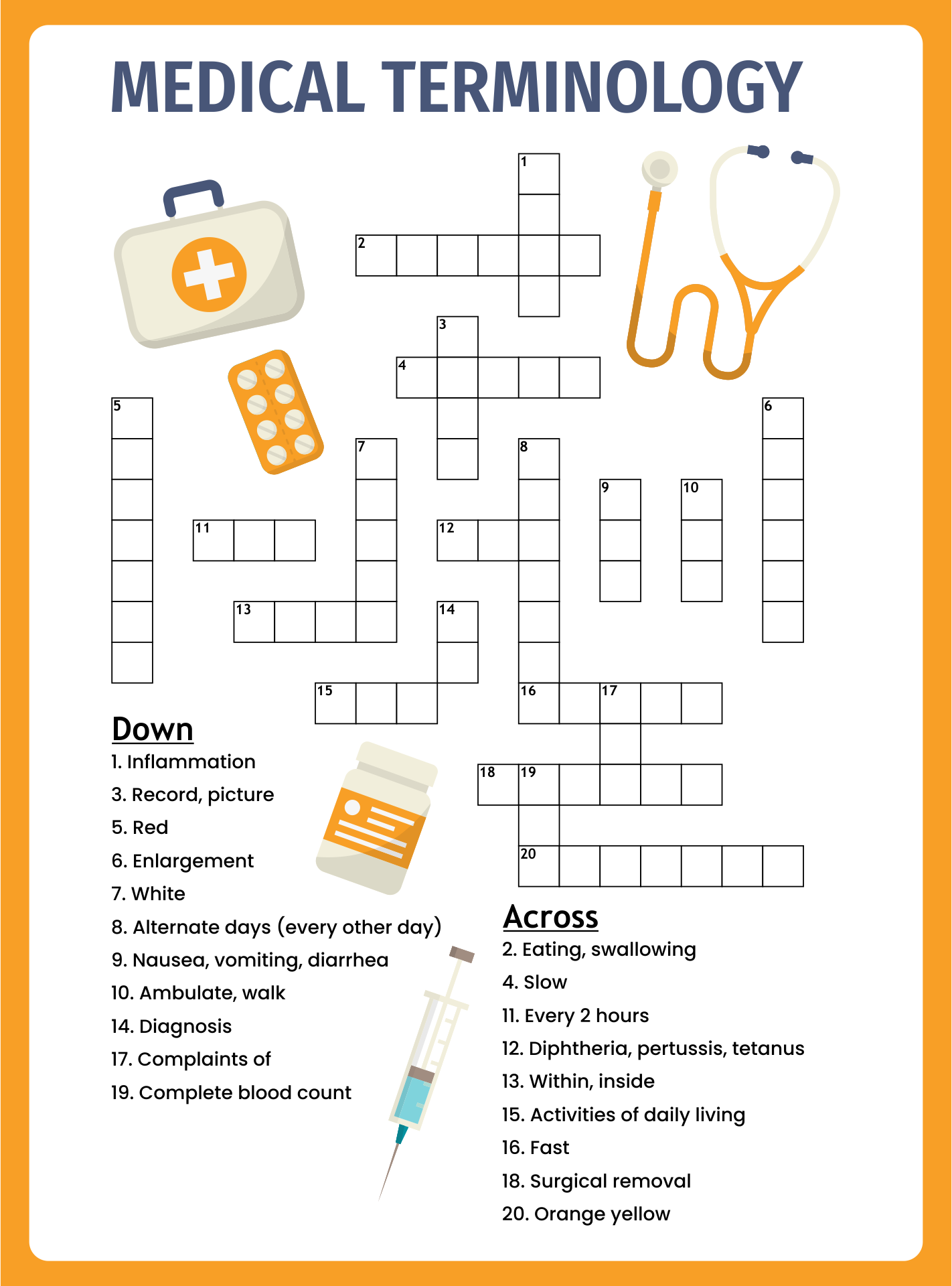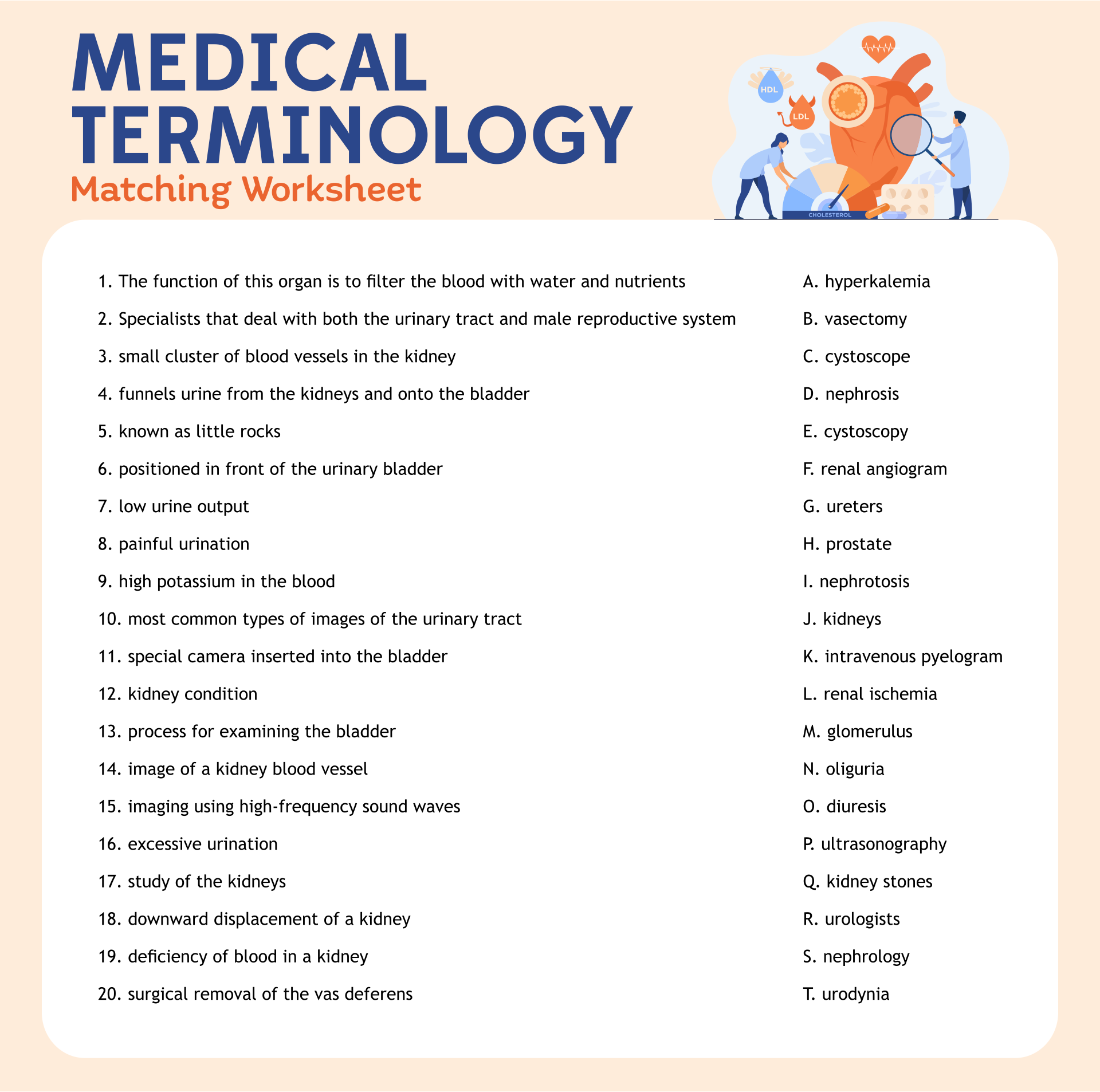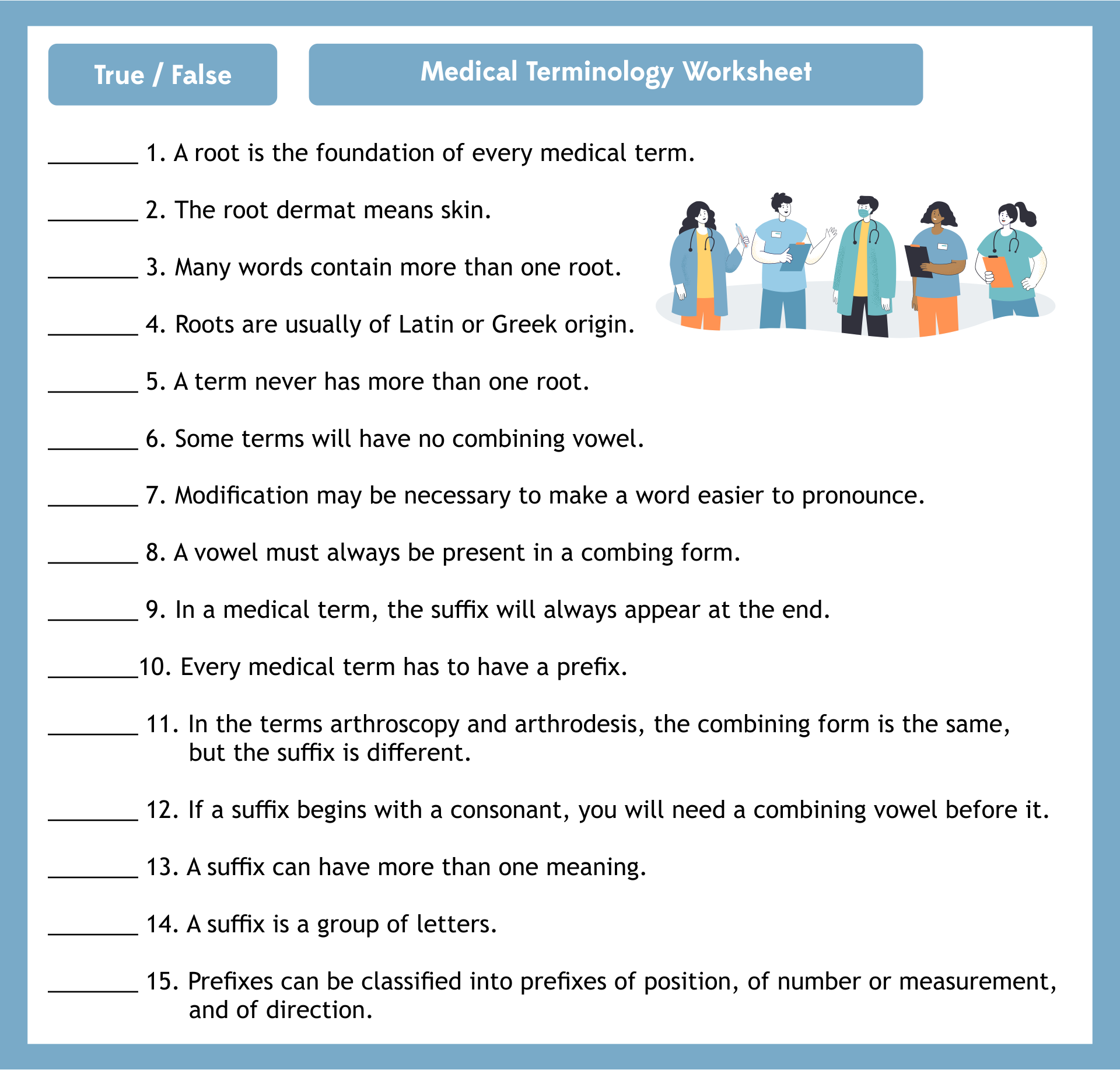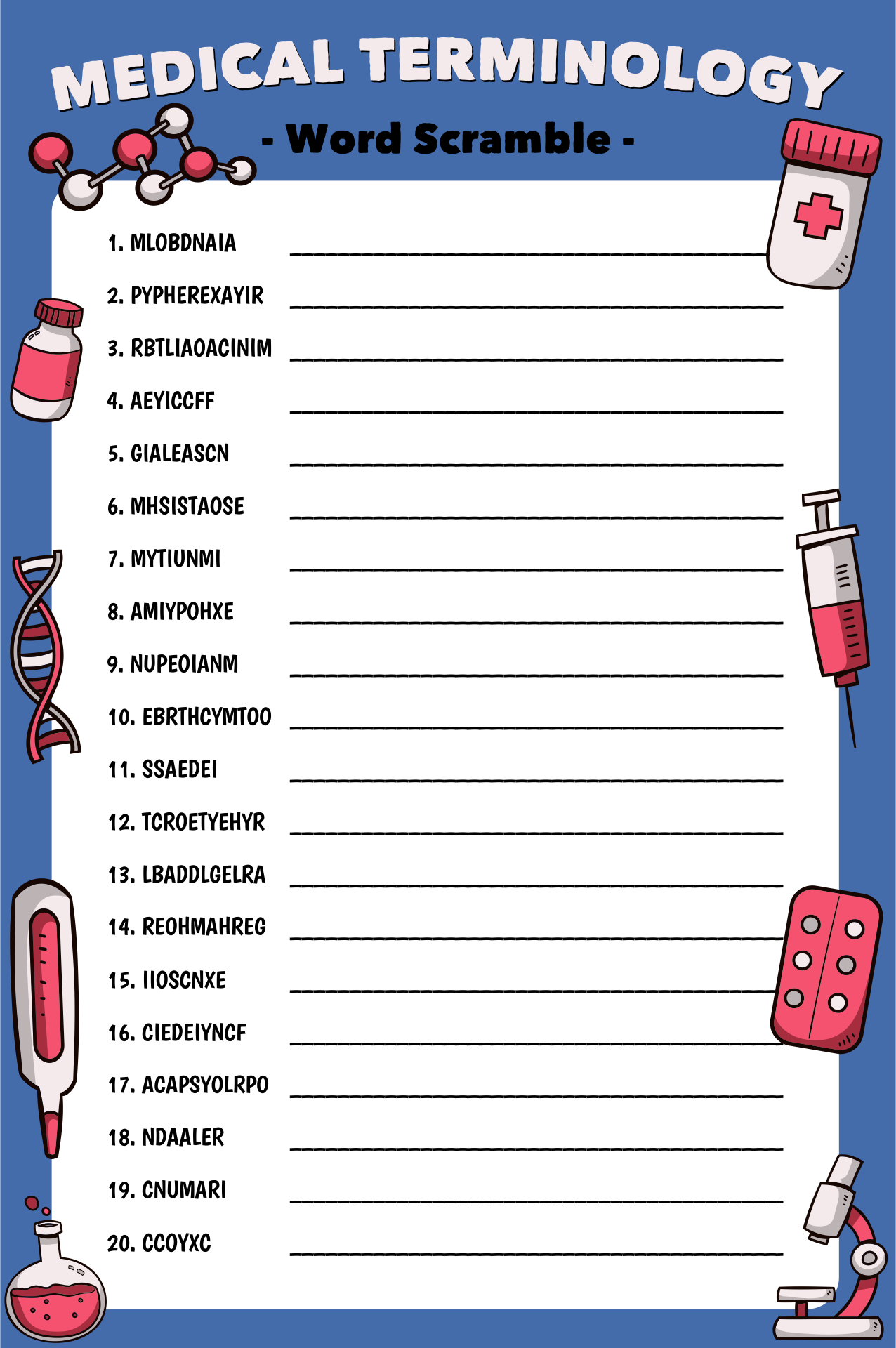
Mastering Medical Terminology: The Indispensable Role of Medical Vocabulary Worksheets
In the intricate and ever-evolving landscape of healthcare, precision in communication is not merely a professional courtesy; it is a fundamental pillar of patient safety and effective care. At the heart of this precision lies an expansive and often daunting vocabulary, a specialized language that underpins every diagnosis, treatment, and interaction. From the basic anatomical terms to complex pathological conditions, pharmacological classifications, and surgical procedures, mastering medical terminology is non-negotiable for students, aspiring professionals, and seasoned practitioners alike.
However, acquiring this vast lexicon is a significant challenge. It requires not just memorization, but deep contextual understanding, the ability to apply terms correctly in various scenarios, and the confidence to communicate clearly under pressure. This is where medical vocabulary worksheets emerge as an indispensable tool, transforming a formidable task into a structured, engaging, and ultimately achievable learning journey. This article will delve into the critical importance of medical vocabulary, explore the multifaceted benefits and diverse types of medical vocabulary worksheets, and provide guidance on how to effectively design and integrate them into a robust learning strategy.

The Imperative of Medical Vocabulary in Healthcare

The language of medicine is unique, drawing heavily from Latin and Greek roots, prefixes, and suffixes. This linguistic foundation allows for the creation of highly descriptive and precise terms, but it also presents a steep learning curve. Consider the difference between saying "stomach inflammation" and "gastritis" – the latter is not only more concise but also universally understood within the medical community, preventing ambiguity and fostering efficiency.

Accurate medical vocabulary is crucial for several reasons:

- Patient Safety: Misunderstandings due to imprecise language can lead to medication errors, incorrect diagnoses, or inappropriate treatments, with potentially life-threatening consequences.
- Effective Communication: Healthcare is a collaborative effort. Doctors, nurses, pharmacists, therapists, and administrative staff must communicate seamlessly. A shared, precise vocabulary ensures that information is transmitted accurately and efficiently across disciplines.
- Diagnostic Accuracy: Describing symptoms, physical findings, and test results requires specific terms that convey exact meanings to colleagues.
- Documentation and Record-Keeping: Medical records are legal documents. Precise terminology is essential for clear, defensible, and comprehensive patient charts.
- Professional Credibility: Competent use of medical language signals professionalism, knowledge, and confidence to patients and peers.
- Research and Advancement: Understanding and contributing to medical literature, attending conferences, and engaging in research all rely on a solid grasp of terminology.



Given these critical stakes, effective learning tools are paramount.
The Role and Benefits of Medical Vocabulary Worksheets

In this context, medical vocabulary worksheets serve as highly effective, structured learning aids designed to reinforce understanding, improve retention, and facilitate the practical application of medical terms. They move beyond passive reading, engaging learners in active recall and problem-solving, which are crucial for true mastery.
The benefits of incorporating medical vocabulary worksheets into a learning regimen are extensive:

- Active Recall and Retention: Worksheets compel learners to actively retrieve information rather than just recognize it. This process strengthens neural pathways, leading to better long-term memory retention.
- Contextual Understanding: Many worksheets present terms within sentences, case studies, or clinical scenarios, helping learners understand not just what a word means, but how it is used in a practical context.
- Improved Communication Skills: By repeatedly writing and identifying terms, learners build confidence in both their written and oral communication of medical concepts.
- Enhanced Critical Thinking: Exercises that require learners to differentiate between similar terms, analyze symptoms, or choose the best term for a given situation foster critical thinking skills.
- Self-Paced and Flexible Learning: Worksheets can be completed independently, allowing learners to progress at their own speed and focus on areas where they need more practice. They are adaptable for individual study, group work, or classroom assignments.
- Error Reduction: Regular practice with worksheets helps to identify and correct misunderstandings before they translate into real-world errors.
- Preparation for Assessments: Worksheets are excellent preparation for quizzes, exams, and standardized tests, familiarizing learners with common question formats.
- Career Readiness: For students, mastering medical terminology through consistent practice prepares them for the linguistic demands of clinical rotations, internships, and eventual professional practice.
Diverse Types of Medical Vocabulary Worksheets
The versatility of medical vocabulary worksheets lies in their ability to be designed in numerous formats, each targeting different aspects of learning and reinforcing concepts in varied ways:
- Matching Exercises:
- Term to Definition: Classic matching of a medical term with its precise definition.
- Term to Image: Matching terms with diagrams of anatomy, instruments, or conditions.
- Term to Synonym/Antonym: Matching terms with similar or opposite meanings.
- Fill-in-the-Blanks:
- Sentence Completion: Learners complete sentences using appropriate medical terms, often from a word bank.
- Paragraph Completion: More advanced, requiring terms to complete a clinical narrative or description.
- Multiple Choice Questions (MCQs):
- Testing understanding of definitions, application in scenarios, or identification of correct terms.
- True/False Statements:
- Assessing factual knowledge and the ability to discern correct medical statements.
- Crossword Puzzles and Word Searches:
- Engaging and fun ways to reinforce spelling and recognition of terms. Crosswords, in particular, require definitional understanding.
- Root, Prefix, and Suffix Exercises:
- Breaking down complex terms into their component parts and understanding how these elements combine to form meaning. This is fundamental for deciphering unfamiliar terms.
- Anatomy Labeling Diagrams:
- Requiring learners to label parts of the human body, organs, or systems. This links terminology directly to visual structures.
- Case Study Analysis/Scenario-Based Exercises:
- Presenting a short patient scenario and asking learners to identify relevant medical terms, diagnose conditions using appropriate language, or describe treatments. This is excellent for applying knowledge.
- Drug Name/Classification Exercises:
- Matching generic drug names with brand names, classifying drugs by their mechanism of action or therapeutic use, or identifying common drug suffixes (e.g., -pril for ACE inhibitors).
- Spelling and Pronunciation Drills:
- Exercises focused purely on correct spelling, or prompts for pronunciation practice (though pronunciation usually requires an audio component or instructor guidance).
Designing Effective Medical Vocabulary Worksheets
Designing impactful medical vocabulary worksheets requires a thoughtful approach to ensure they are clear, challenging, and conducive to deep learning.
- Define Clear Learning Objectives: Before creating, determine what specific terms or concepts learners should master. Is it anatomical terms, disease processes, or pharmacology?
- Target the Audience Level: Tailor the complexity to the learner’s current knowledge base (e.g., beginner, intermediate, advanced).
- Incorporate Variety: Mix different exercise types within a single worksheet or across a series to maintain engagement and address various learning styles.
- Ensure Real-World Relevance: Whenever possible, embed terms within clinical contexts, common patient complaints, or everyday healthcare scenarios. This makes the learning more meaningful and memorable.
- Provide Clear Instructions: Ambiguous instructions can hinder learning. Make sure learners know exactly what is expected of them.
- Include an Answer Key: Crucial for self-assessment and independent learning. Explanations for answers, especially for MCQs or complex scenarios, are highly beneficial.
- Use Visual Aids: Diagrams, illustrations, and images can significantly enhance understanding, especially for anatomical terms or procedural descriptions.
- Progressive Difficulty: Start with simpler exercises (e.g., matching definitions) and gradually introduce more complex ones (e.g., case studies, root analysis).
- Solicit Feedback: If possible, test worksheets with a small group of learners and gather feedback to refine and improve them.
Integrating Worksheets into Learning Strategies
The true power of medical vocabulary worksheets lies in their versatile integration into various learning environments and strategies:
- Individual Study: As a primary tool for self-study and revision. Learners can print them out or use digital versions.
- Classroom Activities: Used for in-class exercises, group work, or quick quizzes to assess understanding. They can serve as a warm-up or a cool-down activity.
- Homework Assignments: Reinforcing concepts taught in lectures or readings.
- Pre-Clinical Preparation: Helping students familiarize themselves with terms they will encounter during clinical rotations.
- Continuing Professional Development (CPD): For practicing professionals looking to refresh their knowledge, learn new terminology related to emerging fields, or prepare for certification exams.
- Online Learning Platforms: Many digital platforms incorporate interactive worksheets, flashcards, and quizzes, often with immediate feedback.
Overcoming Challenges and Maximizing Impact
While highly effective, learners might face challenges such as rote memorization without understanding, or becoming overwhelmed by the sheer volume of terms. To maximize the impact of medical vocabulary worksheets:
- Encourage Conceptual Understanding: Design worksheets that require application and analysis, not just recall.
- Promote Spaced Repetition: Encourage learners to revisit worksheets periodically to combat the forgetting curve.
- Combine with Other Methods: Use worksheets in conjunction with flashcards, mnemonics, peer discussions, and actual clinical exposure. Hearing and speaking terms in a real-world setting reinforces worksheet learning.
- Make it Engaging: Incorporate elements of gamification or competition if used in a group setting.
- Personalization: Encourage learners to create their own worksheets or flashcards based on their specific learning needs and areas of weakness.
Conclusion
Mastering medical vocabulary is an ongoing journey, foundational to safe, effective, and compassionate healthcare practice. The complexity and sheer volume of terms can be daunting, but with the right tools, this challenge becomes surmountable. Medical vocabulary worksheets, through their diverse formats and active learning approach, stand out as an indispensable resource in this journey. They provide the structured practice, contextual understanding, and repetitive exposure necessary to transform passive knowledge into confident, precise communication. By strategically designing and integrating these worksheets, educators and learners alike can ensure that the language of medicine, far from being a barrier, becomes a powerful enabler of excellence in patient care.
